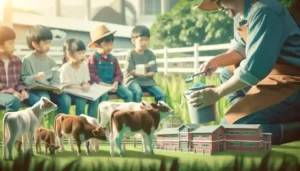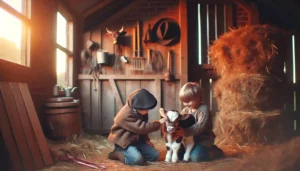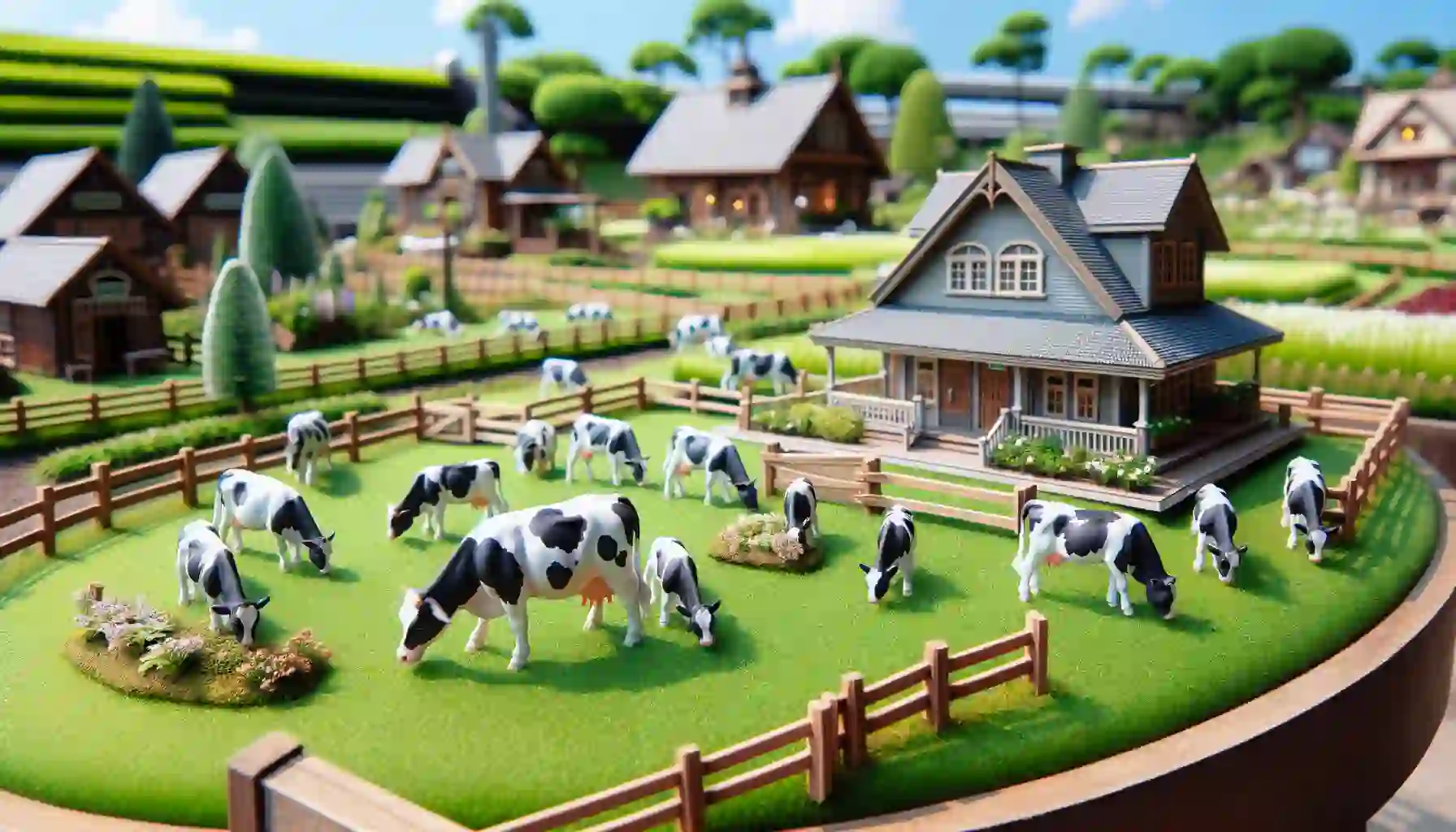Introduction
Welcome to the enchanting world of miniature cows. These adorable animals have captured the hearts of many, offering a unique blend of farm life charm and pet-like companionship. Miniature cows are not just smaller versions of their larger counterparts; they bring a whole new dimension to farming and pet care. This blog post delves into the myriad of reasons why miniature cows are gaining popularity. From their manageable size to their environmental benefits, we’ll explore what makes these tiny bovines an excellent choice for both seasoned farmers and enthusiastic hobbyists alike.
Overview of Miniature Cows
Miniature cows, as the name suggests, are a smaller version of the standard cattle breeds. Typically, they stand between 36 to 48 inches tall at the shoulder when fully grown. This size makes them ideal for smaller farms or those with limited space. Despite their diminutive stature, miniature cows exhibit all the characteristics of their larger relatives, including a variety of colors, patterns, and even the same gentle demeanor.
Breeding miniature cows has become a meticulous process, focusing on health, temperament, and size. Farmers and breeders aim to produce animals that are not only smaller but also hardy and capable of thriving in diverse environments. These cows can live up to 15-20 years, making them long-term companions for their owners.
The appeal of miniature cows extends beyond their size. They require less food, space, and overall maintenance compared to traditional cattle. Additionally, they can be kept on smaller parcels of land, making them a feasible option for people living in areas where space is a premium. Despite their size, they are efficient grazers and can contribute to the management of grasslands and pastures.
Popularity and Appeal
The popularity of miniature cows is on the rise, and it’s easy to see why. They offer an eco-friendly alternative to traditional livestock, consuming less and producing less waste. This makes them an ideal choice for sustainable farming practices. Moreover, their friendly and docile nature makes them perfect for families, especially those with children. They are not just livestock; they are pets that can form strong bonds with their owners.
Miniature cows also play a role in educational settings, such as schools and petting zoos, where they help teach children about agriculture, animal care, and responsibility. Their manageable size reduces the intimidation factor, making interactions more accessible and enjoyable.
Furthermore, the novelty of miniature cows adds to their appeal. They are a conversation starter and a point of interest for visitors and passersby. Owning a miniature cow can be a unique and rewarding experience, providing both the joys of animal companionship and the satisfaction of sustainable living.
The appeal of miniature cows goes beyond their adorable appearance. They offer practical benefits for small-scale farmers, contribute to sustainable agriculture, and provide a source of joy and companionship. As more people discover these miniature marvels, their popularity is sure to continue growing.
Understanding Miniature Cows:

What Are Miniature Cows?
Miniature cows, as their name suggests, are smaller versions of the full-sized cows we commonly see in fields and farms around the world. These adorable animals have captured the hearts of many, not just for their size but for their gentle nature and the benefits they bring to small-scale farming. Unlike their larger counterparts, miniature cows stand at about 36 to 42 inches tall at the hip, making them a perfect fit for smaller farms and homesteads.
Their size doesn’t detract from their utility. In fact, miniature cows can do almost everything a full-size cow can do. They produce milk, can be raised for meat, and make excellent pets due to their docile temperament. This versatility makes them an excellent choice for sustainable living enthusiasts, small acreage farmers, and those looking for a unique pet. Moreover, caring for a miniature cow requires less feed, space, and overall resources, aligning well with eco-friendly living practices.
Characteristics and Size
The charm of the miniature cow lies not only in its utility but also in its manageable size and friendly disposition. Typically, a miniature cow weighs between 500 to 700 pounds, which is significantly less than the 1,000 to 1,800 pounds of a regular cow. This reduced size makes them easier to handle, less intimidating, and more accessible to a wider range of people, including children and those new to farming.
These smaller cows are known for their robust health and longevity, often living longer than their larger cousins. Their compact size also means they are less likely to damage pastures and fencing, a common concern with larger livestock. As a result, they are an excellent choice for rotational grazing systems, contributing to soil health and pasture management.
Breeds and Types
There is a variety of miniature cow breeds, each with its unique characteristics and advantages. Some of the most popular breeds include the Miniature Hereford, Dexter, Lowline Angus, and Miniature Jersey. Each breed has its specific traits, such as the Miniature Hereford, known for its docile temperament and ease of care, making it an ideal choice for novice farmers and families.
The Dexter breed, on the other hand, is renowned for its dual-purpose capabilities, providing both high-quality meat and rich milk, making it a versatile option for small-scale sustainable farming. Lowline Angus are celebrated for their excellent beef quality and efficient grazing, while Miniature Jerseys are sought after for their creamy milk and friendly nature.
Choosing the right breed depends on an individual’s farming goals, whether it’s milk production, beef, or simply having a gentle and unique pet. Each breed of miniature cow offers its own set of benefits, but all share the common traits of being manageable, efficient, and a joy to keep.
The History of Miniature Cows
Miniature cows, with their compact size and gentle demeanor, captivate many. These smaller versions of traditional cattle breeds have a history as rich and varied as their larger counterparts. Let’s delve into the origins and development of miniature cows, before exploring their place in the modern world.
Origins and Development
The journey of miniature cows began centuries ago. Initially, they were not bred for their size but rather emerged as natural size variations within herds. Over time, specific breeding programs started to intentionally reduce the size of these animals for various reasons. In Europe and Asia, smaller cow breeds were preferred for smaller farms, as they required less space and food. This practical approach to farming led to the development of several miniature cow breeds.
As breeding techniques advanced, the focus shifted from mere utility to include aesthetic and novelty aspects. Miniature cows became prized for their unique appearance and became symbols of status among the elite. The Dexter breed, for example, originating from Ireland in the late 18th century, is one of the earliest recognized miniature breeds, known for its hardiness and dual-purpose qualities.
Modern Miniature Cows

Today, miniature cows enjoy popularity beyond traditional farming. They are found in petting zoos, as part of eco-friendly agricultural projects, and increasingly as pets. Breeds like the Miniature Hereford, Lowline Angus, and Miniature Jersey are sought after for their manageable size, efficiency, and compatibility with sustainable farming practices. Their smaller footprint means they are better suited for smaller plots of land, reducing the environmental impact of dairy production.
The appeal of miniature cows extends to their temperament. Known for being docile and friendly, they make excellent companions. This has led to a surge in interest among hobby farmers and those seeking alternative livestock. The trend towards organic and small-scale farming has further boosted their popularity, positioning miniature cows as an ideal choice for the future of sustainable agriculture.
Miniature cows represent a fascinating blend of historical significance and modern-day practicality. As we move towards more environmentally conscious living, these charming animals stand out not just for their size but for their role in a more sustainable and intimate approach to farming.
The Benefits of Raising Miniature Cows:
Raising miniature cows comes with a unique set of advantages. These small but mighty animals offer economic and environmental benefits that large cattle cannot match. Let’s delve into the economic upsides, specifically focusing on the reduced costs and space requirements, alongside the profitability and variety of products they offer.
Economic Advantages
Lower Costs and Space Requirements: Miniature cows, with their diminutive stature, are a game-changer for small farms and homesteads. Unlike their larger counterparts, these animals require significantly less space. This means you can comfortably raise them on smaller parcels of land without compromising their well-being. As a result, the initial investment in land and infrastructure is considerably reduced.
Moreover, the day-to-day expenses associated with raising miniature cows are lower. They eat less than standard cows, translating to reduced feed costs. Their smaller size also impacts other cost areas, such as fencing, housing, and veterinary bills, which are all lower compared to those for larger breeds. This makes miniature cows an attractive option for those looking to venture into livestock farming without the heavy financial burden typically associated with it.
Profitability and Products: Despite their size, miniature cows are surprisingly profitable. They produce a range of products, from milk to meat, similar to their larger counterparts but in proportions more manageable for small-scale farmers and homesteaders. Their milk, often rich and creamy, is perfect for artisanal cheese and butter production, catering to niche markets willing to pay a premium for such products.
Furthermore, breeders of miniature cows can also benefit from selling calves to others interested in raising them, whether for agricultural purposes or as pets. This multiplicity of revenue streams adds to the economic viability of raising miniature cows.
In summary, miniature cows present an economically advantageous option for small-scale farming. Their lower cost and space requirements, combined with the profitability of their products, make them an attractive investment. These small but mighty animals not only cater to the practicalities of modern farming but also open doors to niche markets, offering a sustainable and profitable farming venture.
Environmental and Social Benefits
Miniature cows not only charm us with their size but also offer notable environmental and social advantages. Their smaller stature means they require less space and resources, making them a sustainable choice for small farms and homesteads. This aspect, combined with their friendly nature, turns them into ideal candidates for educational programs and community projects.
Sustainability and Eco-friendliness
Miniature cows represent a step towards more sustainable farming practices. Due to their size, they consume less food and water than their larger counterparts. This translates into a smaller ecological footprint, a crucial factor in today’s environmentally conscious society. Moreover, they produce less waste, reducing the methane emissions commonly associated with cattle farming. This makes them an eco-friendly option for those looking to minimize their impact on the planet.
Their adaptability to various climates and conditions further underscores their sustainability. Miniature cows can thrive in smaller pastures, making them perfect for rotational grazing practices. This method improves soil health, promotes biodiversity, and prevents overgrazing, contributing positively to the environment. By choosing miniature cows, farmers and hobbyists alike can enjoy the benefits of cattle rearing while adhering to principles of sustainability and eco-friendliness.
Community and Educational Aspects
Miniature cows excel in bringing communities together. Their manageable size and docile temperament make them excellent for educational programs, where children and adults alike can learn about agriculture, animal care, and sustainable living. Schools, and local farming events often feature miniature cows to engage and educate the public about farming in a hands-on manner.
Moreover, these animals can play a pivotal role in therapy and special needs programs, offering comfort and companionship to those who interact with them. By fostering a closer connection to nature and agriculture, miniature cows help cultivate a sense of responsibility and stewardship towards the environment among community members.
Their presence in local projects can also stimulate social cohesion, as individuals come together to care for these animals. Whether it’s through cooperative farming initiatives or community gardens that include miniature cows, these endeavours promote a sense of belonging and collective effort towards a sustainable future. In essence, miniature cows are not just farm animals; they are catalysts for education, community building, and environmental stewardship.
Caring for Miniature Cows

Caring for miniature cows involves understanding their basic needs, including suitable shelter and proper nutrition. This section explores the essentials of providing for these adorable animals, ensuring they live healthy, happy lives.
Shelter and Space
Miniature cows require less space than their full-sized counterparts, but they still need a comfortable, safe environment. A sturdy barn or shed is crucial to protect them from harsh weather. Inside, each cow should have ample room to move, lie down, and stand up comfortably. Ventilation is key to keeping the air fresh and disease-free. Outside, a secure paddock or pasture provides the necessary space for grazing, exercise, and social interaction. Fencing should be robust and high enough to prevent escapes, considering the curious nature of miniature cows. Proper shelter and space are not just about physical well-being; they also support the animals’ mental health, reducing stress and promoting contentment.
Feeding and Nutrition
Nutrition plays a vital role in the health of miniature cows. Their diet primarily consists of quality grass and hay, ensuring they receive the necessary fiber for proper digestion. However, their smaller size means they need less food than larger breeds. Overfeeding can lead to obesity and health issues, so it’s essential to monitor their intake. Additionally, providing a mineral supplement can help fulfill their nutritional requirements not met by grass alone. Clean, fresh water must be available at all times, as hydration is crucial for their overall well-being. By understanding and meeting their dietary needs, owners can ensure their miniature cows thrive.
Health and Wellness
Caring for a miniature cow involves understanding their health and wellness needs. Proper care can prevent many common issues and ensure your miniature cow lives a happy, healthy life. Let’s delve into the health concerns these animals may face and how preventative measures and veterinary care play crucial roles in their wellbeing.
Common Health Issues
Miniature cows, like all animals, are susceptible to certain health problems. Some of the most common issues include respiratory infections, which can occur due to poor ventilation in living quarters. Digestive troubles are also frequent, often resulting from improper diet or sudden changes in feed. Parasitic infestations, such as lice and worms, can affect their overall health and productivity, necessitating regular deworming and external parasite control measures.
Foot problems, including laminitis and hoof rot, can occur, especially if living conditions are not clean or if the cow is overweight. Regular hoof care and monitoring of their living environment are essential to prevent these conditions. Additionally, miniature cows can experience reproductive issues, such as difficulty calving (dystocia), particularly if bred to larger breeds or if not properly monitored during pregnancy.
Preventative Care and Veterinary Needs
To safeguard the health of your miniature cow, a comprehensive preventative care plan is crucial. This includes regular vaccinations to protect against common diseases and a consistent deworming program to prevent internal and external parasitic infections. Providing a balanced diet tailored to their specific nutritional needs is also vital to prevent digestive issues and maintain optimal health.
Regular veterinary check-ups are essential to catch any health issues early and to keep up with vaccinations and parasite control. Your vet can offer advice on proper hoof care to prevent foot problems and guidance on managing weight to avoid issues like laminitis.
In case of reproductive concerns, working closely with your vet ensures you’re prepared for breeding and calving, minimizing risks to both the cow and her offspring. By prioritizing health and wellness through preventative care and regular veterinary attention, you can enjoy the company of your miniature cow for many years.









Your point of view caught my eye and was very interesting. Thanks. I have a question for you.
Wow, superb weblog structure! How long have you ever been running
a blog for? you made blogging glance easy. The entire glance of your site is excellent,
as smartly as the content material! You can see similar: ecommerce and here ecommerce
This webpage is fabulous. The superb information shows the maker’s earnestness. I’m dazed and envision additional such incredible presents on.